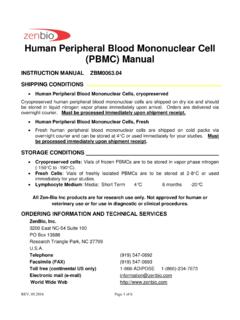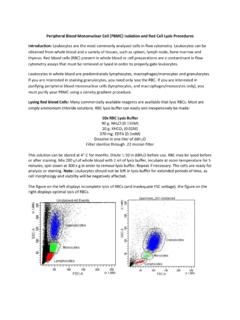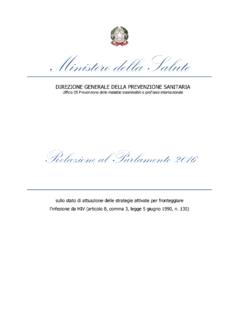Transcription of Combination Immune Checkpoint Inhibitors for the Treatment ...
1 Combination Immune Checkpoint Inhibitors for the Treatment of human Colon Carcinoma in NSG Mice Engrafted with human pbmc . Martin R. Graf; Jason M. Davis; Anya Avrutskaya; Lynnelle Thorpe; Mark Ellison; Vivek Mahajan; Thi Bui; Aidan Synnott; Robert J. Mullin and Paula L. Miliani de Marval. Charles River Discovery Services, Morrisville, NC, USA 4 SUMMARY and CONCLUSIONS 2 MATERIALS AND METHODS PK and Efficacy studies: Female NSGTM mice (Jackson laboratory), were 8-10 weeks were engrafted with human peripheral blood mononuclear cells ( pbmc ) at 3x107 cell/animal (Hemacare; pbmc -HLA-A*01/01, pbmc -HLA-A*01/02; pbmc - HLA- A*03/24).
2 Seven days post engraftment, animals were implanted with 5x106 RKO tumor cells in 50% Matrigel, subcutaneously in the right flank. Dosing began on Day 1 in mice with established RKO tumors (group mean 70 mm3). The study endpoint was a tumor volume of 1500 mm3 in the control group for the RKO I study and Day 18 in the RKO II study in which samples were collected for flow cytometry analysis. Treatment outcome was based on percent tumor growth inhibition (%TGI), defined as the percent difference between the median tumor volumes (MTVs) of treated and control mice. Percent TGI was calculated using the following formula: %TGI = [1 -(MTVdrug treated/MTVcontrol)] x 100.
3 The results of two independent studies are shown here. Statistical Significance was determined using the Mann-Whitney U test. Flow Cytometry Analysis Peripheral blood was collected in tubes containing K2 EDTA and Immune cell populations were analyzed by flow cytometry. All data were collected on a FACSC anto II (BD) and analyzed with FlowJo software (Tree Star, Inc.). Initial sequential gating on singlets (FSC-H vs. FSCA), leukocytes (SSC-A vs. FSC-A) and live cells was performed followed by identification of Immune cells populations based upon the following phenotype markers: hCD45+; CD4 (hCD45+CD3+CD4+), CD8 (hCD45+CD3+CD8+), T cell populations were further defined as effector (EFF) and effector memory (EM) based upon CCR7 and CD45RO expression.
4 The cell lines A375, A2058, SK-MEL-24, SK-MEL-5, HT-1080, Colo205, RKO, HCT116, MDA-MB-231, Calu6, HCC827, SKOV3, were analyzed by flow cytometry for the expression of PD-L 1 and PDL-2 . 1 ABSTRACT Over the past decade there has been an increasing interest for preclinical models useful for evaluating the efficacy of Checkpoint inhibition-based cancer immunotherapies. Moreover, the recently developed humanized mouse models offer a unique tool to evaluate the anti-tumor response of the human Immune system to Checkpoint Inhibitors . In a model development study we established that animals successfully engrafted with huPBMC developed graft versus host disease (GvHD) in 5 to 6 weeks.
5 Here we present the response to the Checkpoint Inhibitors pembrolizumab (anti-PD-1 ) and ipilimumab (anti-CTLA-4 ) in the human RKO colon carcinoma (HLA-A* 01) xenograft model following the engraftment of HLA matched huPBMC in NSG mice. Combination of pembrolizumab with ipilimumab therapy resulted in a significant inhibition of tumor growth. Analysis of the human Immune cell subsets showed the major fraction of the human CD45 cells were T-cells. There was a significant increase in the T-cell population of the Combination Treatment group as compared to the control group in which CD8 T-cells predominated.
6 In summary, this study supports the use of huPBMC-NSG mouse model to test the tumor response to Immune - Checkpoint based therapies as it shows significant tumor growth inhibition associated with CD8 T expansion. In addition, this study demonstrates that there is a therapeutic window to evaluate cancer treatments before the onset of xenogeneic GvHD in this model. 3 RESULTS 5 ACKNOWLEDGEMENTS # 161 Cell line % PD-L1 + % PD-L2 + A375 melanoma HT-1080 fibrosarcoma SK-MEL-5 melanoma HCC827 lung Colo205 colon SK-MEL-24 melanoma RKO colon MDA-MB-231 breast HCT116 colon Calu6 lung SKOV3 ovarian A2058 melanoma Table I: Evaluation of the Expression of PD-L1, PD-L2, In human Cell Lines by Flow Cytometry Analysis Figure 1: Evaluation of multiple hPBMC donors for engraftment levels in NSG mice.
7 Group n Regimen 1 Donor Cell # Injection Site Schedule 1 4 pbmc Donor 1 A*01/01 3 x 107 iv day 1 2 4 pbmc Donor 2 A*01/02 3 x 107 iv day 1 3 4 pbmc Donor 3 A*01/02 3 x 107 iv day 1 4 4 pbmc Donor 4 A*03/24 3 x 107 iv day 1 Treatment Regimen MTV (n) Statistical Significance Group n pbmc : A*01/01 Agent g/animal Route Schedule Day 18 %TGI vs G1 vs G4 1 5 3 x 107 Polyclonal human IgG 200 ip biwk x 3 936 (5) --- --- --- 2 6 3 x 107 ipilimumab 100 ip biwk x 3 600 (6) 36 p< p< 3 5 3 x 107 pembrolizumab 100 ip biwk x 3 320 (5) 66 p< ns 4 6 3 x 107 ipilimumab pembrolizumab 100 100 ip ip biwk x 3 320 (6) 66 p< --- Treatment Regimen Group n pbmc .
8 A*01/01 Agent g/animal Route Schedule 1 8 3 x 107 Polyclonal human IgG 200 ip biwk x 3 2 8 3 x 107 Ipilimumab (anti-hCTLA-4) pembrolizumab (anti-hPD-1) 100 100 ip ip biwk x 3 d18 d15 Tx Tx -12d d4 d11 d8 d1 -5d HuPBMC 50-80mg Tumors Start Tx Tx Tx Tx Tumor implant d13 d27 End Treatment Regimen MTV (n) Statistical Group n pbmc Agent g/animal Route Schedule Day 37 %TGI Significance 1 7 No Polyclonal human IgG 100 ip biwk x 3 1639 (7) --- --- 2 7 No ipilimumab 100 ip biwk x 3 1711 (7) -4 ns 3 7 No pembrolizumab 100 ip biwk x 3 2168 (7) -32 p< 4 7 No ipilimumab pembrolizumab 100 100 ip ip biwk x 3 2013 (7)
9 -23 ns Control IgG Ipi Pembro Pembro +Ipi Treatment Table for PK study Mean Body Weight of Engrafted NSG Mice Identification of Immune Cell Subsets from Blood Samples Collected on Days 8 and 22 from NSG Humanized Mice Representative Immune Cell profile of hPBMC Prior to Engraftment hCD45% hCD3% hCD4% hCD8% Day 8 Day 22 Day 8 Day 22 Day 22 Day 22 Day 8 Day 22 pbmc Donor 1 A*01/01 ND ND ND ND pbmc Donor 2 A*01/02 pbmc Donor 3 A*01/02 pbmc Donor 4 A*03/24 Figure 2: Evaluation of the Efficacy of Ipililumab (anti-hCTLA-4) and Pembrolizumab (anti-hPD-1) Combination Therapy in the human RKO Colorectal Carcinoma in Humanized NSG Mice.
10 Protocol Design in the RKO Study I Treatment MTV(8): 1759 mm3 MTV(8): 1077 mm3 TGI: 42%) * * * (p< ) Mean Tumor Volume Growth and Body Weight Figure 3: Evaluation of the Efficacy of Ipililumab (anti-hCTLA-4) and Pembrolizumab (anti-hPD-1) Alone and in Combination in the human RKO Colorectal Carcinoma in Humanized NSG Mice. Protocol Design and Tumor Growth Inhibition in humanized NSG mice in the RKO II Study Protocol Design and Tumor Growth Inhibition in NSG mice in the RKO III Study Mean Tumor Volume Growth in the RKO II Study Percent hCD45 in Blood from Humaniized NSG Mice in the RKO II Study Mean Tumor Volume Growth in the RKO III Study Using Non-Engrafted NSG Mice Effector Memory CD8 T cells Predominate in the RKO Tumors and is Associated with Reduced PD-1 Expression in the Pembrolizumab Treatment Groups Multiple hPBMC donors were evaluated for engraftment in NSG mice and demonstrated similar levels of circulating hCD45





